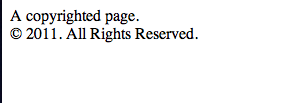Step 3 - Controllers
Last updated Apr 30th, 2019 | Page history | Improve this page | Report an issue
Support the team building MODX with a monthly donation.
The budget raised through OpenCollective is transparent, including payouts, and any contributor can apply to be paid for their work on MODX.
Backers
Budget
$285 per month—let's make that $500!
Learn moreThis tutorial is part of a Series:
- Part I: Creating a Custom Resource Class
- Part II: Handling our CRC Behavior
- Part III: Customizing the Controllers
- Part IV: Customizing the Processors
Creating the Resource Controllers¶
Okay, remember how in Step 1 we told MODX where our controllers/ directory was, via the "getControllerPath" method? To refresh your memory, here's the code from
return $modx->getOption('copyrightedresource.core_path',null,$modx->getOption('core_path').'components/copyrightedresource/').'controllers/';
As you might have guessed, we're going to put two files into the core/components/copyrightedresource/controllers/ directory. Create the directory if you haven't already and then create a file named create.class.php:
<?php
class CopyrightedResourceCreateManagerController extends ResourceCreateManagerController {
public function getLanguageTopics() {
return array('resource','copyrightedresource:default');
}
}
Next add update.class.php:
<?php
class CopyrightedResourceUpdateManagerController extends ResourceUpdateManagerController {
public function getLanguageTopics() {
return array('resource','copyrightedresource:default');
}
}
So when we're done with that, our file structure should look something like this:

And that's all we need to get our custom controllers up and running. You don't even have to include the getLanguageTopics call, but we did so we can load our custom Lexicon for the page. Read that again: you do not need to create the getLanguageTopics() function! You do need to create the controllers and create the classes, but you do not need to add any functions to them. If you're confused, remember our hot tip from Part I: any time you extend a PHP class, you should review the parent class that you're extending. In this case, you can take a gander at the parent classes:
-
manager/controllers/default/resource/create.class.php -
manager/controllers/default/resource/update.class.php
In case you need a brush up on your object-oriented programming, any method in the ResourceUpdateManagerController or ResourceCreateManagerController can be overridden - a common one to override is "loadCustomCssJs", which would allow you to add in your own custom CSS/JS and such for your own custom UI for your CRC.
Now you can go to the Resource tree, and create a "Copyrighted Page", and it will load the Resource editing panel. Note, since we didn't override anything in the controller, it will look exactly like the normal Resource editing panel. But, after you create your page and view it in the front-end, you'll note that the copyright is automatically appended:

Wonderful! This should give you a good understanding of how resources are handled by MODX. You could stop there, but we'll go on a little bit further to describe how to extend the processors for your CRC. That's where things get more interesting... you can customize the behavior of the manager and control where things get saved in the database, and all sorts of things...
Support the team building MODX with a monthly donation.
The budget raised through OpenCollective is transparent, including payouts, and any contributor can apply to be paid for their work on MODX.
Backers
Budget
$285 per month—let's make that $500!
Learn more











